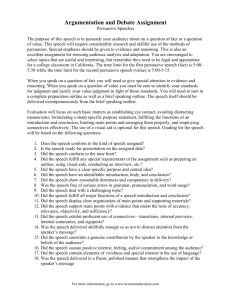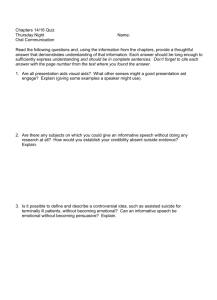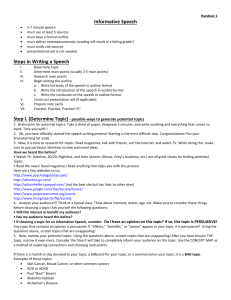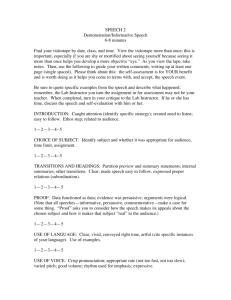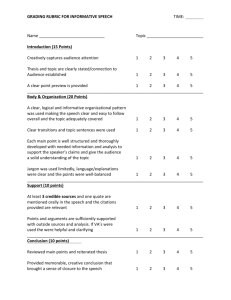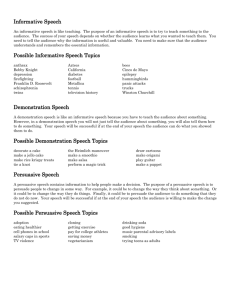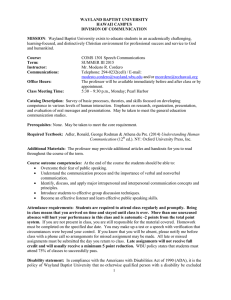Public Speaking Assignment
advertisement
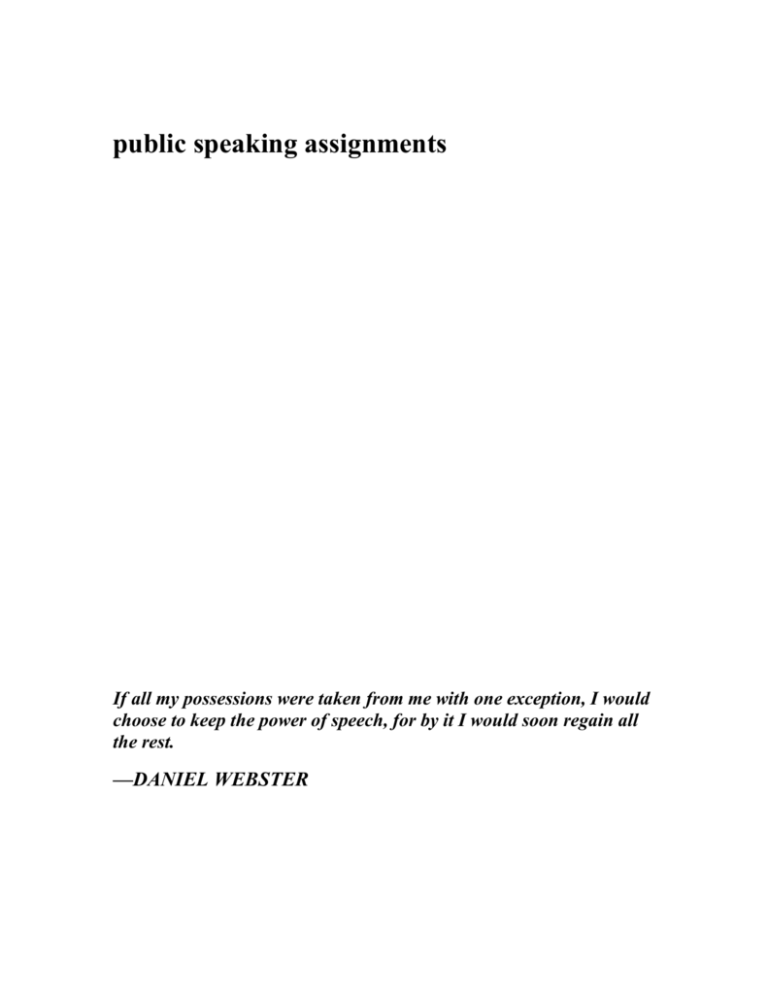
public speaking assignments If all my possessions were taken from me with one exception, I would choose to keep the power of speech, for by it I would soon regain all the rest. —DANIEL WEBSTER INFORMATIVE SPEECH ASSIGNMENT: Cultural Perspective Speech: 50 points Speech plan: 25 points Time limit: 5-6 minutes 1. The purpose of this speech is twofold: a) you are asked to research an area that is of interest to you and to your audience; and b) you are asked to examine this research and decide what information would be of particular benefit for your audience. As you prepare your speech, remind yourself of the distinction we have discussed between informative and persuasive presentations. Be aware of your intentions, which should be reflected in your specific purpose and central idea/thesis statement. 2. You are expected to define, explain, describe, or demonstrate a specific aspect of your cultural experience as a human being. This speech should examine a person, an idea, a belief, a tradition or ritual, a practice, a skill, an event, an object, a symbol, or any other unique aspect of your life from an ethnic or sociological sub-group experience. The cultural perspectives speech is a specific variety of the informative speech. Therefore, you are encouraged to emphasize conveying information to your audience rather than persuading your audience to change action or attitude. Rather your purpose should be to share information about who you are and how your heritage contributes to your identity. Some examples of such a speech might include one of the following: Describe the roots of your family heritage, exploring the reasons why or the ways in which your family ended up in the Northeast (or wherever they live); Define the meaning of an abstract value (e.g. freedom, family, individualism, community, justice, strength) from the perspective of your unique cultural experience; Describe and discuss a historical event of significance to your culture (e.g. a U.S. war or conflict, Cinco de Mayo, Holocaust); Demonstrate and explain a specific skill, tradition, object, symbol, or ritual relating to your cultural heritage (e.g. Passover seder, Ramadan, couscous). Explain the significance of this item from a personal and cultural perspective. 3. Be sure to provide appropriate, accurate, credible support for your information. Cite the sources of your information in the body of your speech. 4. Give the speech extemporaneously. Use note cards, do NOT read from a piece of paper. 5. You are required to use a visual aid in this speech. Give some thought to this component. Ask me if you are not sure what to use. It can be an overhead, a poster, or other form of visual aid as described in your book. Be sure that it illustrates a key point of your speech. The images and text must be large enough to read at the back of the room. A transparency made from normal 12 pt type is not acceptable. You may use handouts, but they do not count as visual aids. Your visual aid must be integrated into your speech. It is insufficient to hold it up at the end and say, "Oh yeah, here's my visual aid." Refer to your book for details about visual aids. PERSUASIVE SPEECH: Policy Speech: 100 points Speech Plan: 75 Time limit: 8-9 minutes 1. Choose a contemporary social problem facing Canada. This topic may be related to your second informative presentation relating to multiculturalism. If you choose this route, your presentation must go beyond your earlier presentation with substantive research and claims. Otherwise, check the newspaper and relevant sources to find a problem that concerns you. Research the problem and its causes and effects, and develop a plan to address the problem. The topic should be of interest to you and to your audience. Your topic should be one with at least two clear sides, and one with which at least most of your audience is likely to disagree. It will be easier to assert and defend a position if you actually know something about the topic and believe in your position. Be sure you are comfortable taking a strong stand. The purpose of this assignment is to give you the opportunity to defend a position important to you, as well as to learn how to construct sound, strong arguments for a particular audience and situation. The goal of this speech is to change, by some degree, the thought or action of your audience in relation to your chosen subject. However, this is not a value speech. Thus, your presentation must center around an explicitly stated policy claim. In other words, "should" or "ought" are to be used in the thesis explicitly. Please recognize that the power and passion of your presentation depends on the homework you do. Investigate the issue and relate it to your audience's interests and values. Be aware of issues and values that weigh on your audience's mind. Additionally, remember to construct and deliver arguments. An argument is not simply a claim but a claim with support. Therefore, it is vital that you support your argument with evidence rather than simply providing the audience with your opinion on the topic. 2. Research your speech. The better speeches are those that are well-researched and offer quality supporting evidence to bolster the claims offered. The speaker is at an advantage by providing different types of supporting evidence. This implies that you will seek out current research on the topic, and that you refrain from using only one or two types of evidence. Remember also to cite your sources and emphasize your credibility. Find published and/or interview sources that will help you support your arguments and enhance your speaker credibility. Avoid plagiarism. 3. Format: a) Establish the NEED or the PROBLEM. - Define the problem and prove its existence and importance. - Establish that the problem causes harm, describe to whom and how badly people are harmed. How extensive is the problem? - Thoroughly analyze and discuss the harms and negative effects of this problem. Consider harms not only to people, but to the environment, the economy, social ills, etc. - Determine why the problem exists. What is its cause, or causes? Can the cause be eradicated? This may affect how you go about solving the problem. b) Propose a plan or policy to solve or alleviate the problem. - This should be a detailed solution to the problem. In other words, ending homelessness is much more complicated than “my plan is to end homelessness.” Give specific details of the plan, including organizations that need to be established, procedures to be implemented, and considering who will pay any bills. How will your solution occur? When? Who is in charge? - This does not need to be an original plan that you develop; you may use plans that have been proposed by others. In any case, you must demonstrate that the plan or policy you advocate directly addresses the problem you have defined. c) Outcomes: - Clearly discuss both the positive and negative outcomes likely from the implementation of your proposal. Recognize that any major change to the social structure has its downside, regardless of how many problems it solves. Be realistic. However, if you wish your audience to be persuaded of the benefits of your plan, the positive outcomes should outweigh the negative. 4. You are required to use a visual aid for this speech. 5. As always, deliver your speech extemporaneously from note cards. Do NOT read or memorize your speech! Examples: gays and lesbians should be allowed to marry, Japanese-Canadians who were interred in camps (and their heirs) should be compensated financially, college students should be required to volunteer in literacy clinics on their campuses, the University of Calgary should establish a free lunch program for children in the surrounding neighborhoods. Grading of speeches: An "A" speech: * is an excellent speech. * demonstrates investments of time and energy in organization, preparation and practice. * is delivered smoothly. * cites sources of information in the body of the speech. * engages the audience with eye contact, techniques of audience adaptation, and consideration of the audience's experiences, knowledge, and interests. * makes its specific purpose known. * is clearly informative or persuasive, according to the assignment. * fulfills all of the requirements of the assignment, as detailed on the assignment sheet. A "B" speech: * is above average. * is well-organized. * makes its specific purpose known. * is clearly informative or persuasive, according to the assignment. * demonstrates efforts at smooth delivery (demonstrates some practice). * demonstrates some consideration of the audience. * fulfills most of the requirements of the assignment, as detailed on the assignment sheet. A "C" speech: * is average. * must demonstrate some thought and preparation, including organization. * must attempt to fulfill the assignment. A "D" speech: * does not fulfill the requirements of the assignment. * is not organized. * has not been practiced. An "F" speech: * should be avoided. Do not waste our time. The Speech Plan: General information The speech plan is an organizational preparation tool that will help you make appropriate choices for effective presentations. Used properly, this tool will not only make your experience as a communicator in this class better, it will improve your grades. You will prepare and turn in a speech plan for all presentations in this class. In order to receive credit for your speech plan, it must: a) b) c) include ALL the required elements; be typed, proofread, and grammatically correct; be turned in before you make your presentation. Speech plans that do not fulfill these requirements will earn zero points. Basically, the speech plan is an opportunity for you to work through and explain the decisions that you make as you prepare each presentation. As we will discuss, any strategic interaction requires a speaker to make many choices that will affect the outcome of the conversation. These are the choices that I want you to articulate in each speech plan.

